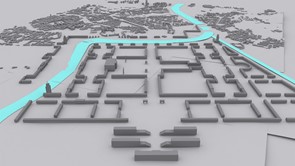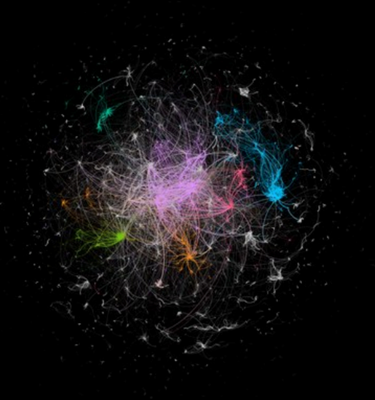“Distance and Criticality”: The Digital Humanities and the Potential for Art History Scholarship with Hubertus Kohle and Emily Pugh
“My thinking about digital art history often takes me back to what art history is, because I think the question of how to use digital technologies and what their influence might be means questioning what it is to do art history, and what I might want to retain of art history—for example, what is something a computer could do, as opposed to an art historian.”
This fourth season of In the Foreground is a special series of five roundtable conversations dedicated to “the Grand Challenges”—a phrase frequently adopted in the sciences to refer to the great unanswered questions that represent promising frontiers—of bringing together digital and computational methods and the social history of art. This series grows out of a colloquium on this topic convened by Anne Helmreich (Associate Director of the Getty Foundation) and Paul B. Jaskot (Professor of Art History at Duke University) at the Clark’s Research and Academic Program in April 2019. Anne and Paul serve as the guest interviewers for this podcast series, for which they have invited back colloquium participants to reflect further on how digital art history might help us explore social history of art’s future, and which digital methods might be effective at analyzing large scale structural issues and modes of visual expression.
In this episode
Paul B. Jaskot speaks with Hubertus Kohle, professor of art history at Ludwig Maximilian University of Munich in Germany, and Emily Pugh, an art historian and the Digital Humanities Specialist for The Getty Research Institute in Los Angeles, on the relation between the digital humanities and the potential for art history. They reflect on how we work as scholars in terms of accessing and documenting archives and data, and the difference in scale between transferable computational methods as opposed to project-specific solutions. Both guests discuss how engagement with the digital might grant us distance to see our discipline anew, or reveal biases within the history of art, while also expressing some concern about a plateau in innovation, or a resistance in art history to collaborating with practitioners from adjacent fields who might open new directions within the digital. Throughout, the conversation circles around the question of how computational approaches may equip us to become more critical art historians.
TRANSCRIPT

Hubertus Kohle is professor of art history at Ludwig Maximilian University of Munich in Germany. He specializes in eighteenth- to twentieth-century German and French painting and art theory, as well as digital art history. He has published on such varied topics as the artists Adolph Menzel, Max Beckmann, Henri Matisse, Jacques-Louis David, and Hyacinthe Rigaud; the Eiffel tower; the reception of the French revolution in the nineteenth century; social art history in France in the eighteenth and nineteenth centuries; the history of art criticism; Denis Diderot’s art theory; the computer in art history; and internet art.

Emily Pugh is an art historian and currently serves as the Digital Humanities Specialist for The Getty Research Institute in Los Angeles, where she oversees the scholarly components of the Institute’s digital art history projects, such as the Getty Provenance Index Remodeling project and the Harald Szeemann Digital Seminar. Previously, she served as the first Robert H. Smith Postdoctoral Research Associate, with special responsibilities for digital humanities projects, at the Center for Advanced Study in the Visual Arts in Washington, DC. She has several years of experience with digital publications, having served from 2001 to 2013 as the lead web developer for the online peer-reviewed journal Nineteenth-Century Art Worldwide. She was also the lead developer for NCAW’s “Digital Humanities and Art History” series and co-authored a report on this series (Spring 2016). She is the author of Architecture, Politics, and Identity in Divided Berlin (University of Pittsburgh, 2014), and her essays on the Cold War urban built environment have appeared in the Journal of the Society of Architectural Historians, Centropa, and Space and Culture.

Paul B. Jaskot is professor of art, art history, and visual studies at Duke University in Durham, North Carolina, where he also co-directs the Digital Art History & Visual Culture Research Lab (formerly, the Wired! Lab). His research focuses on the political history of Nazi art and architecture as well as its postwar cultural impact. He is the author of The Architecture of Oppression: The SS, Forced Labor, and the Nazi Monumental Building Economy (Routledge, 2000) and The Nazi Perpetrator: Postwar German Art and the Politics of the Right (University of Minnesota, 2012), among other publications. A founding member of the ongoing Holocaust Geography Collaborative, which explores the use of GIS and other digital methods to analyze the spatial history of the Holocaust, Paul contributed co-authored essays to their volume, Geographies of the Holocaust (Indiana University, 2014), the first book to address the analysis of Holocaust spaces with GIS. Currently, he is continuing his collaborative work in an NEH-funded analysis of the spaces of the Nazi ghettos of Occupied Europe as well as a solo-research project on the history of the construction industry in Germany, 1914–1945. Paul is currently President of the National Committee for the History of Art (2020–2024), the US affiliate to the International Committee of the History of Art (CIHA).
This conversation was recorded on November 7, 2021. Photo: Jeff Carrion

